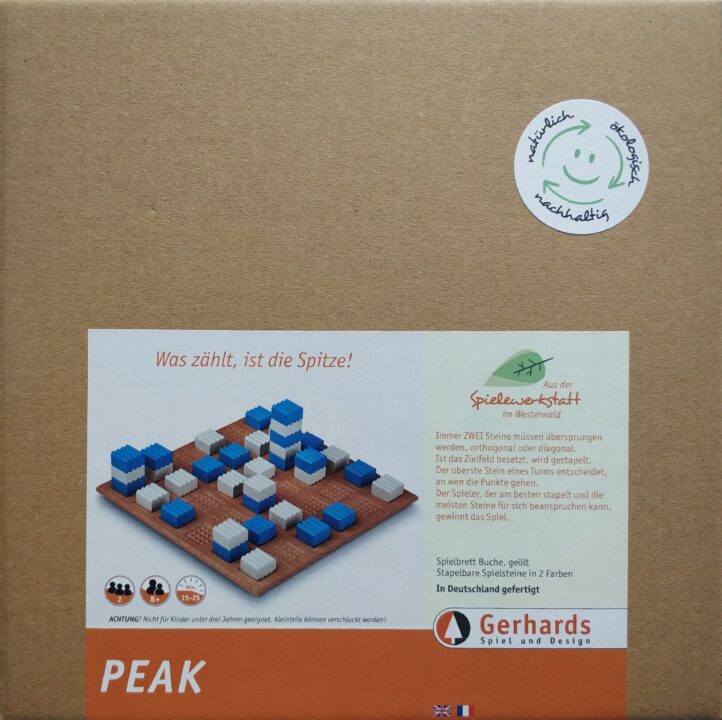Welcome, fellow board game enthusiasts! Today, we’re checking out a board game that’s been taking my game nights by storm: “Peak.” If you’ve been itching for a game with strategy, lively player interaction, and the promise of humor, then stick around. In this review, we’ll dig into the nitty-gritty details, from gameplay mechanics to component quality, to see if “Peak” deserves a spot on your shelf or if it’s one to pass on. Grab your favorite snack, settle in, and let’s get started—because you won’t want to miss this peak into the game’s world!
How It Plays
Setting Up
First, gather three to six brave souls. Open the box, untangle the rules from the chaos within, and place the board on a sturdy table (preferably one that doesn’t wobble). Distribute player pieces, set up resource markers, and give everyone their cards. Shuffle the deck well – no peeking!
Gameplay
Each turn, players roll dice and move their pieces. Make strategic decisions (or wildly guess, no judgment) to collect resources and build structures. Use cards from your hand wisely to outwit opponents or pull surprise moves. Strategic planning is key, but watch out for those unpredictable dice rolls – they’re always lurking, ready to mess with your plans!
Winning the Game
To claim victory in Peak, be the first to reach the highest score by dominating designated areas or completing specific objectives. Watch your friends like hawks, because they’re sneaky and can unexpectedly leapfrog to the top when you least expect it. One moment you’re the king of the hill, the next – a tumbleweed blowing past your fallen empire.
Want to know more? Read our extensive strategy guide for Peak.
A High Point in Gameplay Mechanics
Gather ’round, folks, because today we’ll chat about “Peak”—a board game that took my game night by storm! Now, I’m no stranger to trying out new games, but “Peak” sure surprised me with its unique gameplay mechanics. Let’s pour a cup of imagination and get into the nitty-gritty of what makes this game tick.
So, “Peak” takes the standard board game tropes and flips ’em like a pancake! Players stack tiles to build mountains, aiming for that coveted summit. You know how in some games you’re just rolling dice and hoping for the best? Not here! In “Peak”, strategy rules the roost. Each player must carefully place their tiles, like playing Tetris with a really pretty landscape. The catch? You and your competitors can strategically mess with each other’s stacks. Sneaky tactics! But be careful, one wrong tile will send your mountain tumbling down faster than a Jenga tower. It’s like playing a game of chicken with gravity!
However, a hiccup I found was the rulebook. It’s like they crammed War and Peace into a pamphlet! A little confusing at first, but once you crack the code, it’s all smooth sailing. While strategy is key, luck’s still a teasing wrench in the gears. A tiny slip of the hand or a misplaced tile can change the whole game. As for balance, well, it’s like trying to walk a tightrope; one player’s misstep can be another’s triumph.
So now, just like that awkward silence at a party, let’s change the subject. Coming up next, we’ll explore what makes player interaction in “Peak” a mountain of fun!
Get Ready for Some Peak Player Interaction
Alright, so let’s talk about player interaction in Peak. I’ll be honest, the name itself already sets us up for some high-altitude fun. Imagine you’re climbing a mountain, not literally of course, unless your living room is more adventurous than mine! But in the game, you’re strategizing with other players to race to the summit.
The beauty of Peak lies in its ability to blend strategy with player interaction. You might think you’re all about solo climbing, but in this game, your friends can help – or hinder – your progress, with a well-timed card or action. My pal Dave, the eternal wild card, always finds a way to turn the tide of the game. Last time, he cleverly blocked my path with a yellow “Detour” card when I was just inches from victory. I may have plotted revenge, but let’s keep that between us!
The game thrives on these kinds of interactions. Whether you’re forming alliances or breaking them faster than a reality TV show (I’m looking at you, Tanya!), each move creates a lively table conversation. You’re not just playing against the game, but against the unpredictable nature of your friends. It’s what makes every game so thrilling and different!
And while I wish I could say it’s all roses, sometimes the interaction can feel a bit unbalanced. There’s nothing more frustrating than being ganged up on. But hey, that’s the name of the game, right?
In our next section, we’ll take a peek at how Peak stands up to multiple plays. Is it a one-hit wonder, or can you replay it for a lifetime? Stay tuned!
Exploring Replay Value in Peak
Replay value is that magical quality that makes you crave playing a game again and again. Now, with Peak, replay value takes center stage, like me with a karaoke mic after two glasses of wine. Peak challenges our brains with its strategic mechanics that change each time you play. It’s one of those rare gems where the game feels fresh every round.
What keeps me coming back to Peak is the unpredictability of its player interactions. My buddy Dave, who once declared himself a board game ‘master,’ is still reeling from that time I outsmarted him using a tactic he didn’t see coming. It’s these kinds of experiences that keep Peak at the top of the stack on game night.
The unique set of challenges and situations in each game ensures that no two sessions are the same. With so many possible strategies to explore, every playthrough presents a new opportunity to finesse your tactics. And let’s not forget about the variety of roles and card combinations that switch up the gameplay. Honestly, I wouldn’t be surprised if Peak enthusiasts start forming their own secret societies.
Of course, as with any game worth its salt, Peak has its own learning curve. But once you’re over that bump, you’re on a rollercoaster of strategic thrills. Trust me, you won’t be storing this one away anytime soon!
Stay tuned, because next up is the component quality of Peak, where we’ll get into the nitty-gritty of cardboard versus plastic. Does the touch and feel stand up to all those glorious game sessions? Let’s see!
Exploring the Component Quality of Peak
When it comes to board games, component quality is the cherry on top of the experience. Now, let’s talk about Peak. You know, the game that’s been occupying my dining room table more than my actual dining. Peak does a pretty good job in the component department, but let’s dive into the details.
First up, the board itself is a sturdy piece of artwork. It doesn’t feel like a thin slice of cardboard that crumbles at the sight of a spilled drink. You know, the kind that makes you question your life’s choices when it gets warped? Thankfully, Peak dodges that disaster with style.
The pieces are solid little nuggets of joy. I love how when you drop one, it doesn’t bounce away like it’s auditioning for the Olympics. They’re weighty enough to feel satisfying but not so heavy that you think you’ve accidentally picked up a gym weight. Plus, they are colorful, which keeps things lively and not reminiscent of your grandma’s drab parlor.
However, I did find the cards to be a bit thin. They bend quite easily, reminding me of the time I tried to impress friends with my card shuffling skills and ended up with a card origami. If you plan to play Peak often, grabbing some card sleeves might be a smart idea.
In conclusion, while Peak isn’t flawless, its impressive component quality definitely adds value to the gameplay. Would I recommend it? Absolutely! Just watch out for those bendy cards.
Conclusion
After countless hours of strategizing, laughing, and maybe a little bit of harmless cheating, I can say that ‘Peak’ is a delightful strategy game that keeps you on your toes. Sure, the rulebook might be a bit of a head-scratcher at first and the cards might get a little wobbly, but the fun overshadows the tiny hiccups. With its engaging player interaction and endless tactical possibilities, each game feels fresh and exciting. If you’re looking for a game that combines a bit of luck with a ton of strategy, then ‘Peak’ is worth climbing for.


